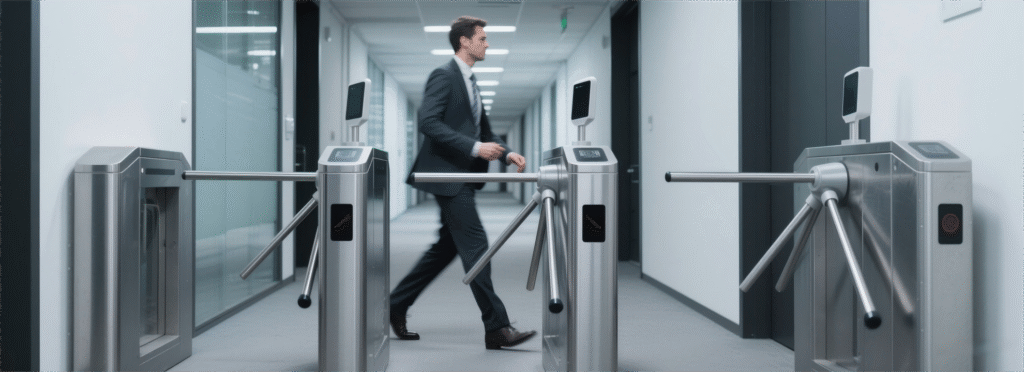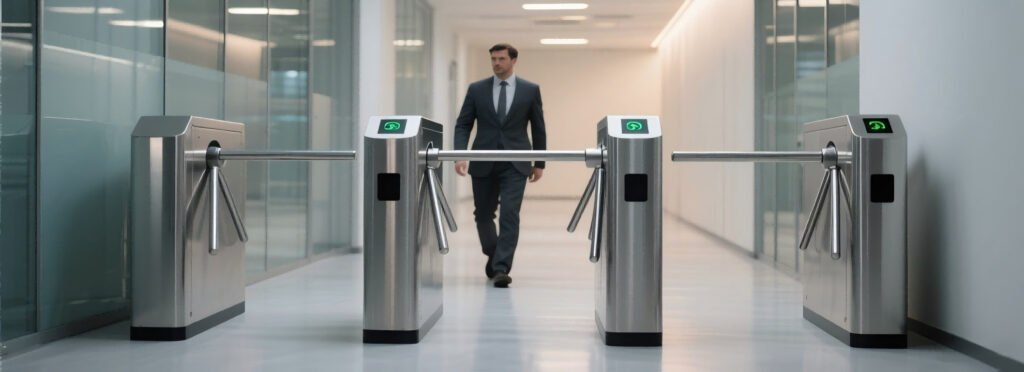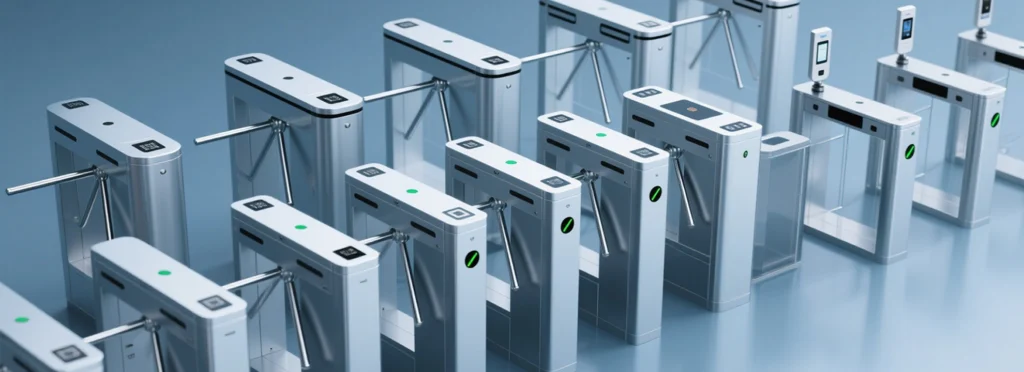Tripod Turnstile
Rising Security Awareness in a Connected World
In today’s fast-paced and increasingly connected world, security has become a top priority for businesses, public facilities, and individuals alike. Rising concerns over unauthorized access, theft, and personal safety are prompting organizations to invest in smarter, more reliable access control solutions.
Countries such as the United States, Germany, Japan, and Singapore have seen widespread adoption of advanced access systems in workplaces, public transportation, and educational campuses. Meanwhile, emerging markets in Southeast Asia, the Middle East, and Latin America are rapidly embracing cost-effective smart security solutions as urbanization and infrastructure projects accelerate.
With growing awareness of security risks and compliance regulations, facilities are looking beyond traditional locks and manual checks. They want systems that not only prevent unauthorized access but also collect data, improve operational efficiency, and enhance user experience. This trend has created a surge in demand for intelligent access control solutions, including the versatile tripod turnstile, which balances affordability, functionality, and modern technology integration.
From Mechanical Barriers to Smart Systems
Tripod turnstiles have evolved significantly from their early days as simple, mechanical barriers. Initially, these devices were low-cost solutions used primarily for basic crowd control. Their simplicity and durability made them a favorite in budget-conscious venues such as small offices, gyms, and local transportation hubs.
Over time, as organizations recognized the importance of security, efficiency, and data insights, tripod turnstiles evolved into digital and intelligent systems. Modern tripod turnstiles now integrate seamlessly with electronic ticketing, ID verification platforms, and employee management software. Facilities of all sizes—from small businesses to large corporate campuses—are adopting these solutions to enhance security, monitor entry, and streamline operations.
Key Technology Integrations
The transformation of tripod turnstiles is powered by cutting-edge technologies, enabling faster, more secure, and user-friendly access:
RFID & QR Codes:
Instant scanning for staff and visitors reduces queues and improves flow in high-traffic areas. RFID turnstiles and QR-enabled gates are particularly popular in gyms, public transport, and event venues.Biometric Recognition:
Fingerprint, facial recognition, and palm vein scanners provide high-accuracy authentication, minimizing the risk of unauthorized access. Biometric tripod turnstiles are increasingly common in corporate offices, laboratories, and secure campuses.Mobile Credentials:
Smartphones and smartwatches replace physical cards, offering a contactless, convenient, and modern solution. Mobile access aligns with the growing trend of digital wallets and wearable technologies.Cloud Management:
Cloud-connected tripod turnstiles allow administrators to monitor entries in real-time, generate analytics reports, and control access remotely. This data-driven approach supports operational optimization and enhances security.
Advantages of Smart Tripod Turnstiles
Smart tripod turnstiles are not only affordable barriers but also intelligent entry solutions that meet the rising demand for modern access control. Their advantages can be analyzed in detail from operational, security, and economic perspectives:
Efficiency in High-Traffic Environments
Traditional mechanical tripod gates often caused delays during peak hours. In contrast, smart tripod turnstiles equipped with RFID, QR code, and biometric authentication provide much faster throughput. For example, in a gym during evening rush hours, members can enter with a simple QR scan on their phones, avoiding queues and staff intervention.
Scalability Across Facility Sizes
Unlike expensive speed gates, tripod turnstiles offer modular scalability. A small co-working space can start with two tripod turnstiles linked to a basic RFID system, while a metro station can deploy dozens of units connected to a central cloud platform. This makes them adaptable to both small businesses and large infrastructures.
Cost-Effectiveness Without Compromise
A tripod turnstile is typically 40–60% cheaper than speed gates or full-height turnstiles. Yet, thanks to smart upgrades, it still provides high-level security and automation. For developing countries or budget-sensitive projects, this balance of cost and intelligence makes tripod turnstiles the preferred access control solution.
Enhanced User Experience
Modern tripod turnstiles are equipped with smooth rotation mechanisms, anti-pinch sensors, and fast authentication modules. This ensures a frictionless passage for users while maintaining strict control. Whether for students entering a library or passengers boarding public transport, the system ensures security without inconvenience.
Industry Adoption Trends
The rise of smart access control awareness has pushed tripod turnstiles into mainstream use across multiple industries. Each sector has unique adoption drivers:
Fitness & Recreation
In gyms, yoga studios, and swimming pools, tripod turnstiles integrated with RFID cards or QR membership codes ensure only registered members can enter. This reduces staffing needs at reception and enhances member experience. Many fitness chains now use mobile apps linked to turnstiles for self-service check-ins.
Corporate Offices
Businesses increasingly adopt biometric tripod turnstiles linked to HR systems. Employees authenticate via fingerprint or facial recognition, automatically logging attendance data. This not only improves workplace security but also reduces manual time-tracking errors. Some companies combine tripod turnstiles with visitor management platforms, streamlining guest registration and temporary passes.
Public Transport
Metro and bus terminals require durable, high-throughput solutions. Tripod turnstiles, often equipped with RFID travel cards or QR-based ticketing, manage thousands of entries per hour. Their robust design and low maintenance cost make them ideal for long-term operation in high-traffic environments.
Education
Universities and colleges deploy tripod turnstiles at dormitory entrances, libraries, and exam halls. Student ID cards or biometric authentication ensure only authorized individuals gain access, preventing unauthorized use of facilities. Additionally, administrators benefit from attendance records and crowd monitoring during large events like lectures or graduation ceremonies.
Events & Venues
Concert arenas, stadiums, and exhibition halls use tripod turnstiles to verify tickets quickly and securely. By integrating with event management platforms, they can detect fraudulent or duplicated tickets instantly. At the same time, they provide organizers with valuable data on crowd flow, peak entry times, and visitor demographics.
Future Outlook
As global security awareness and digital transformation accelerate, tripod turnstiles will continue to evolve with new technologies. The next phase of development will focus on AI, sustainability, and deeper integration:
AI-Powered Verification and Behavior Analysis:
Artificial Intelligence will enhance biometric recognition, enabling faster, more accurate, and even emotion-aware authentication. Future tripod turnstiles may analyze body language or detect suspicious behaviors, adding another layer of proactive security.Integration with Mobile and Cloud Ecosystems:
Mobile-first societies will drive further adoption of smartphone and smartwatch access. Coupled with cloud management, administrators will manage multi-location turnstile networks from a single dashboard, improving operational visibility and centralized control.Eco-Friendly and Energy-Efficient Designs:
With sustainability in focus, manufacturers are developing energy-saving motors, recyclable materials, and solar-powered turnstile systems. This not only reduces environmental footprint but also appeals to organizations with green certifications and ESG goals.Expansion into Developing Markets:
Affordable yet intelligent, tripod turnstiles are expected to see rapid adoption in Southeast Asia, Africa, and South America, where urbanization and public infrastructure growth demand secure but cost-efficient solutions. Their adaptability and lower upfront investment will make them a key technology in global smart city projects.
Conclusion
The tripod turnstile has evolved from a simple mechanical barrier into an intelligent, connected access control solution. By integrating technologies such as RFID, biometrics, mobile credentials, and cloud management, it now delivers not only reliable security but also efficiency, data insights, and a smoother user experience. Its cost-effectiveness compared to other turnstile types makes it a practical choice for gyms, offices, universities, transport hubs, and event venues.
Looking ahead, tripod turnstiles will continue to benefit from AI-powered verification, eco-friendly designs, and mobile-first access solutions. As security awareness grows worldwide and smart city projects expand, these turnstiles will remain a key component of modern access control systems, ensuring safer and smarter environments for a connected world.




